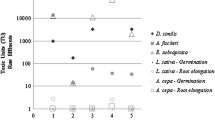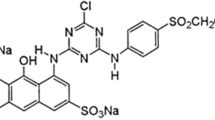Abstracts
This study evaluated toxicity level of produced water effluent on indigenous organisms in Delta state, Nigeria. Four test organisms, Vibrio fischeri, Palaemonetes africanus, Tympanosomas fuscatus, and Tilapia guineensis, were selected for toxicity assessment using effluent streams from treated produced water and water from the produced water recipient environment. Representative samples of treated produced water effluent were collected from the bulk header within the oil terminal and within the discharge environment. Acute toxicity tests were carried out using the Microtox® Model 500. The results of the acute toxicity tests on V. fischeri revealed that the average inhibitive concentration (IC50) for treated produced water at 5 min and 15 min was 22.20% and 31.17% and the no effect concentration (NOEC) and low effect concentration (LOEC) at 5 min and 15 min was 5.63% and 5.63%, respectively. In the recipient water, at 5 min and 15 min, IC50 estimate was of 33.57% and 47.02% while the NOEC and LOEC were 5.63% and 5.63%, respectively. The average IC50, NOEC, LOEC, toxicity unit-acute (TUa), toxicity unit-chronic (TUc), and toxicity factor (TF) toxicity values for P. africanus were 80.606%, 66.990%, and 73.13%; 1.24, 1.49, and 2066.82; 42.24%, 6.165%, and 11.936%; 2.37, 16.21, and 25.54 in treated and recipient water, respectively. In T. guineensis, average IC50, LOEC, NOEC, TUa, TUc, and TF were 4.86%, 1.786%, 1.059%, 20.60, 94.34, and 269.72 and 5.090%, 1.828%, 1.070%, 19.65, 93.46, and 282.78 for treated produced water and recipient environment, respectively. There was no mortality in T. fuscatus var radula exposed to both treated produced water and recipient water.











Similar content being viewed by others
Data availability
Research data can be made available on reasonable request from the corresponding author.
References
Aghoghovwia, O. A., & Izah, S. C. (2018). Toxicity of glyphosate based herbicides to fingerlings of Heterobranchus bidorsalis. International Journal of Avian & Wildlife Biology, 3(5), 397–400.
Aidar, E., Sigaud-Kutner, T., Bicega, M. C., Schinke, K. P., Gianesella, S. M., & Braga, E. S. (1999). Evaluation of produced water toxicity from an oil maritime terminal through Skeletonema costatum toxicity tests. Revista Brasileira de Oceanografia, 47(2), 137–144.
Ajuzieogu, C. A., & Odokuma, L. O. (2018). Comparison of the sensitivity of Crassostrea gigas and Vibrio fischeri (Microtox) for toxicity assessment of produced water. Journal of Advances in Biology & Biotechnology, 1–10.
Ajuzieogu, C. A., Odokuma, L. O., & Chikere, C. B. (2018). Toxicity assessment of produced water using microtox bioassay. South Asian Journal of Research in Microbiology, 1(4), 1–9.
Akinsorotan, A. M. (2013). Histopathological effect of acutely toxic levels of palm oil mill effuent on gill and liver of Nile tilapia fingerlings. Internasional Journal Of Scientific and Engineering Research, 4(3), 2229–5518.
Akinsorotan, A. M., Ajisodun, A. F., Izah, S. C., & Jimoh, J. O. (2019). Acute toxicity of paraquat dichloride on fingerlings of Oreochromis niloticus.
Arivu, I., Muthulingam, M., & Jiyavudeen, M. (2016). Toxicity of paraquat on freshwater fingerlings of Labeo rohita (Hamilton). International Journal of Scientific and Engineering Research, 7(10), 1965–1971.
Babatunde, M. M., & Oladimeji, A. A. (2014). Comparative study of acute toxicity of paraquat and galex to Oreochromis niloticus. International Journal of Advanced Scientific and Technical Research, 4(3), 437–444.
Banaee, M., Sureda, A., Mirvaghefi, A. R., & Ahmadi, K. (2013). Biochemical and histological changes in the liver tissue of rainbow trout (Oncorhynchus mykiss) exposed to sub-lethal concentrations of diazinon. Fish physiology and biochemistry, 39(3), 489–501.
EPA, U. (2002). Municipal solid waste in the United States: 2000 facts and figures. Office of Solid Waste and Emergency Response (5305W), US EPA.
Gabriel, U. U., & Erondu, E. S. (2010). Toxicity of roundup (a glyphosate product) to fingerlings of Clarias gariepinus. Animal Research International, 7(2), 1184–1193.
GESAMP. (2014). Revised GESAMP Hazard Evaluation Procedure for Chemical Substances Carried by Ships (IMO/FAO/UNESCO-IOC/WMO/IAEA/UN/UNEP/INIDO/UNDP) Joint Group of Experts on the Scientific Aspects of Marine Environmental Protection, 2nd Edition, Rep. Stud. GESAMP No. 64, pp. 1–106.
Grigson, S., Cheong, C., & Way, E. (2006). Studies of produced water toxicity using luminescent marine bacteria. WIT Transactions on Biomedicine and Health, 10.
Guideline, O. T. (1992). 203 OECD Guideline for testing of chemicals fish. Acute Toxicity Test.
Incorporation, M. W. (2016). Model 500 Microtox Omni Software for Microtox acute toxicity testing. Modern Water Incorporation.
Inyang, I. R., Okon, N. C., & Izah, S. C. (2016). Effect of glyphosate on some enzymes and electrolytes in Heterobranchus bidosalis (a common African catfish). Biotechnological Research, 2(4), 161–165.
Inyang, I. R., Ollor, A. O., & Izah, S. C. (2017). Effect of diazinon on organosomatic indices and behavioural responses of Clarias gariepinus (a Common Niger Delta Wetland Fish). Greener Journal of Biological Sciences, 7(2), 15–19.
ISO, I. (2007). 11348-3. Water quality—determination of the inhibitory effect of water samples on the light emission of Vibrio fischeri (Luminescent bacteria test)-Part 3: Method using freeze-dried bacteria. International Organization for Standardization, London, UK.
Izah, S. C., Bassey, S. E., & Ohimain, E. I. (2018). Impacts of Cassava mill effluents in Nigeria. Journal of Plant and Animal Ecology, 1(1), 14.
Joel, O. F., Amajuoyi, C. A., & Dede, E. B. (2009). Dose-time effect of crude oil and hydro-test effluent on freshwater and brackish water habitats. Journal of Applied Sciences and Environmental Management, 13(2).
Kokkali, V., & van Delft, W. (2014). Overview of commercially available bioassays for assessing chemical toxicity in aqueous samples. TrAC, Trends in Analytical Chemistry, 61, 133–155. https://doi.org/10.1016/j.trac.2014.08.001
Ladipo, M. K., Doherty, V. F., & Oyebadejo, S. A. (2011). Acute toxicity, behavioural changes and histopathological effect of paraquat dichloride on tissues of catfish (Clarias gariepinus). International Journal of Biology, 3(2), 67.
Ngwoke, O., Igwe, O., & Ozioko, O. H. (2019). Assessment of heavy metal pollution in marine sediments receiving produced water, Delta State. Nigeria. International Journal of Physical Sciences, 14(14), 152–170. https://doi.org/10.5897/IJPS2019.4827
OSPAR, M. (2006). OSPAR Convention for the Protection of the Marine environment of the Northeast Atlantic, meeting of the working group on marine protected areas, species and habitats, Horta, 2-5 Oct. 2006. Criteria and Guidelines for Assessing whether the OSPAR Network of Marine Protected Areas is Ecologically Coherent, first revision. MASH 06/5/3-rev.
Research Council of Norway. (2012). Long-term effects of discharges to sea from petroleum-related activities. The results of ten years' research. St. Hanshaugen No-0131 Oslo.
UNDP. (2006). UNDP Annual Report 2006: Global partnership for development.
Acknowledgements
The authors would like to appreciate the Department of Geology, University of Nigeria, Nsukka for providing the enabling environment for this research.
Author information
Authors and Affiliations
Contributions
MN was instrumental in the research design and field work; he also analyzed and interpreted the Microtex toxicity result. OI supervised the research process and proofread the manuscript. OO compiled the research data and played a major role in writing the manuscript. The final manuscript was read and approved by the authors.
Corresponding author
Ethics declarations
Competing interests
The authors declare no conflict of interest.
Additional information
Publisher's Note
Springer Nature remains neutral with regard to jurisdictional claims in published maps and institutional affiliations.
Rights and permissions
About this article
Cite this article
Ngwoke, M., Igwe, O. & Ozioko, O. Acute toxicity assessment of produced water effluent stream on selected local organisms in Delta state, Nigeria. Environ Monit Assess 193, 254 (2021). https://doi.org/10.1007/s10661-021-09032-y
Received:
Accepted:
Published:
DOI: https://doi.org/10.1007/s10661-021-09032-y




